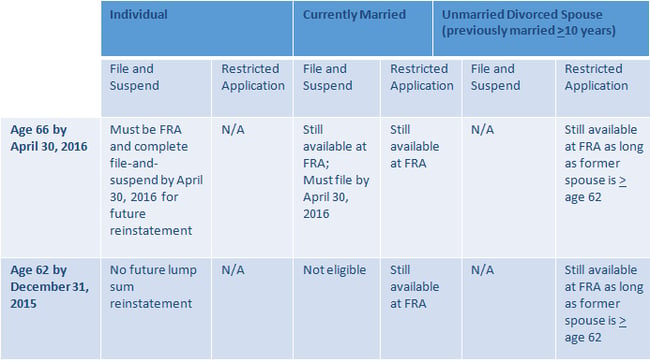Latest Posts
Your money should work for you.
Get the latest tips on how to plan for retirement and make better financial decisions.
Don't worry... we will NOT spam you!
As you may have heard in the news recently, there has been a lot of discussion regarding major changes to the current Social Security filing rules and some of these rules may affect you or someone you know. On November 2, 2015, the Bipartisan Budget Act of 2015 was signed into law. This law, which takes effect on May 1, 2016, will eliminate the Social Security strategies known as “file-and-suspend” and “restricted application.”
What is the file and suspend rule?
File and Suspend is a strategy that allows you to file for your benefits at Full Retirement Age (which is 62), and then immediately, suspend the action to receive your benefits. This strategy would give you the option to retroactively claim benefits if you later decide you should have started collecting at FRA instead. This essentially means you would receive all suspended benefits in a lump sum, lose the 8% per year credits you received by deferring your claims, and receive the amount you would have originally claimed at FRA from then on; if you want to receive your benefits in this way, you must apply for this method by April 29.
Additionally, if you are married, the suspension allows your spouse to file a restricted application.
What is a restricted application?
A “restricted” application allows you to apply for only spousal benefits, equal to one-half of your spouse’s current benefit, while you delay and allow your own future benefit to grow by 8% per year up to age 70. Under this strategy, you must be at full retirement age and your spouse must be receiving their benefit currently, or have to file and suspend.
File and suspend regulations: old vs. new
The old file and suspend rules made it so that couples had the opportunity to maximize their benefits simultaneously by letting one partner file and suspend their benefits while the other would use a restricted application. This strategy allowed each spouse's benefits to continue growing at a momentum of 8% each year while one spouse can continue to collect spousal benefits.
With the new regulations in place, these strategies have now been eliminated. However, depending on your birth date, you may be grandfathered in under the old rules and be able to apply these strategies. For anyone turning 66 by April 30, 2016, you may still take advantage of the file-and-suspend strategy. In order to do so, you must file and suspend by April 29, 2016. Additionally, anyone who turned 62 before December 31, 2015, may file a restricted application at full retirement age (FRA).
How might these strategies benefit me?

Married couples:
If you or your spouse are 66 by April 30, 2016, the person who is 66 can file and suspend by April 29, 2016, and be given the option to retroactively claim suspended benefits as described above. Furthermore, if your spouse was 62 by December 31, 2015, then by you filing and suspending, your spouse will have the option of filing a restricted application when he/she reaches his/her FRA.
If both you and your spouse were 62 by December 31, 2015, one of you may still file a restricted application and claim a spousal benefit at FRA. Your spouse must begin their own benefit for this to work.
Single filers: If you are 66 by April 30, 2016, you can elect to file and suspend by no later than April 29, 2016. This allows you to retroactively claim suspended benefits as a lump sum if you later decide you should have started at Full Retirement Age.
Divorcees: If you meet all the divorced spouse rules and were 62 by December 31, 2015, you can file a restricted application to claim only your divorced spouse benefit at Full Retirement Age, while delaying your own benefit to 70.
Widowed: All widows/widowers will continue to have the opportunity to file a restricted application at FRA to claim survivor benefits and later switch to their own benefits. You may also still take advantage of file and suspend at your FRA.
If you or someone you know may benefit from these strategies, visit the Social Security Administration (www.ssa.gov) website for more detail.



